#tour software solutions
Explore tagged Tumblr posts
Text
Benefits of B2B Portal for Travel Agents
https://blog.technoheaven.net/benefits-of-b2b-portal-for-travel-agents

A B2B travel portal is an essential tool for modern travel agencies looking to optimize operations and provide top-notch travel services. By leveraging Technoheaven’s B2B travel solution, travel businesses can stay ahead of the competition, improve efficiency, and drive long-term growth.
Ready to take your travel business to the next level? Contact Technoheaven today and experience the power of a world-class B2B travel system!
Click here to get a free demo about Technoheaven B2B Travel Portal.
#b2b travel portal#B2B travel software#B2B travel solution#B2B travel system#b2b portal for travel agents#b2b portal#travel technology#travel agent#travel agents#travel industry#tour operator#destination management company
0 notes
Text
youtube
Vergo CRM Software Tutorial: How to Manage CMS for Travel and POS Businesses - DigiVert
In this Vergo CRM software tutorial, we walk you through managing the CMS (Content Management System) section, ideal for travel companies, restaurants, and retail businesses. Vergo CRM by DigiVert is designed to streamline operations, offering specialized features for Travel Companies CRM Software, Travel CRM in India, and CMS management for diverse businesses. Learn how this CRM system empowers tour & travel agencies, DMCs, and other businesses with an easy-to-use interface tailored to Indian GST-based needs. Explore more about Vergo CRM Software:
DigiVert https://digivert.in/ Vergo CRM https://vergocrm.com/ Vergo ERP https://vergoerp.com/
#Travel Companies CRM Software#CRM For Travel#Travel CRM in India#Best CRM Software for Tour & Travel Agencies#Travel Agency CRM Software#B2B Travel Software Solutions for Travel Agencies#Youtube
0 notes
Text
Introducing HeadBox 3D Studio: The Future of Immersive Events - Interview With the CEO
HeadBox, Australia’s leading digital meetings and events platform, is raising the bar with its latest innovation—HeadBox 3D Studio. This state-of-the-art software promises to transform how venues and events teams create and share proposals, offering a unique, personalised experience through interactive 3D tours embedded with AI-generated narrator videos. A New Era for Venues and Hotels For the…
#3D Studio#AI#AI narration#AI technology#AI tools#AI-driven#digital#digital proposals#Eco-Friendly#event management#event planning#event solutions#event tech#event venues#events#global clients#guided tours#HeadBox#HeadBox platform#hospitality#hospitality tools#hotel tours#hotels#immersive#immersive experience#innovation#international clients#language barriers#meeting software#meeting tools
0 notes
Text
Travel Agency Portal
Travel Agency Portal Development Solutions
FlightsLogic is a popular travel agency software that manages and automates sales, bookings, operations, and finances for inbound and outbound tour operators, travel agencies, online travel agencies, and travel companies. It allows them to manage package customization, itinerary creation, and booking to create a large portfolio of travel products such as hotels, flights, transfers, and activities, which increases bookings.

It can simplify the process of online booking, inventory management, package customization, back-office administration, itinerary generation, simplifying business leads, accounting, and other functions, allowing travel agencies to boost bookings while lowering costs.
FlightsLogic, a leading travel technology company, provides a cutting-edge all-in-one travel portal solution that will revolutionize your travel business.
We also offer complete travel portal solutions, GDS integration, and extranet modules to travel agencies. We provide a cutting-edge all-in-one travel portal solution that will transform your travel business. Our Travel Agency Booking Software enables your sub-agents to securely access your live inventory, make reservations, and provide immediate confirmation to their end consumers.
For more information, plz visit our website: https://www.flightslogic.com/travel-agency-portal.php
#travel software development#travel agent system#tour booking system#Travel Agency Portal#Travel Portal Solutions
0 notes
Text
At Amika Softwares, we understand the ever-evolving demands of the Tours and travel industry and the need for efficient, innovative software solutions to stay ahead in this competitive landscape. With our cutting-edge technology and deep industry expertise, we offer a comprehensive suite of software products and services tailored specifically to meet the unique requirements of the Tours and travel sector.
#custom software solution for business#crm for tours and travel#Custom software solution for Tours and travels#Best Custom Software Solution#Best CRM software provider#Custom software solution
1 note
·
View note
Text
#VR#virtual reality software#vr game maker#vr software development#virtual reality environment#vr solutions#custom vr experience#gaming environments#unreal engine environment#video game designer work environment#vr gaming#vr walking platform#vr game development#vr gaming companies#unity vr game development#virtual reality solution#virtual reality solution provider#virtual tour software for real estate#3d virtual tour software#real estate virtual tour software#custom virtual tours#vr real estate#vr clothes shopping#virtual reality shopping experience#vr experience#virtual reality experience#best vr experiences#vr shopping#virtual reality shopping platform#virtual reality store
0 notes
Text

Tour Package Booking System
eWeblink takes the reins in the travel industry, offering an innovative tour package booking system that redefines convenience, efficiency, and seamless travel experiences. As an online tour booking software, eWeblink stands out as the epitome of technological advancement in the realm of travel management. For those seeking for a reliable, user-friendly, and comprehensive tour package booking system, eWeblink's online tour booking software stands tall, promising a journey filled with convenience, customization, and memorable experiences.
Contact us- 9015 8585 65
#eweblink#eweblink technology#tour package booking system#tour booking software#online tour booking software#travel portal development company#travel portal development#travel portal solutions#travel software development
0 notes
Text
Virtual Reality Software Development Company | 360 Degree Service Provider | TechVoyager
Best Virtual Reality Development Company
Utilize technology to feed your content and provide your end users with the finest content experience possible.
Virtual reality (VR) and augmented reality (AR), combined with artificial intelligence (AI) and automation, have altered content strategies and revolutionized the way organizations create information.
Matterport Service Provider In India
AR/VR services, Virtual Commerce for Business have been used in products, processes, and, most significantly, training content to provide a more contextual and visual experience to end users. AR/VR content provides consumers with a tactile experience, allowing them to better understand and learn. Today, AR/VR applications are used across sectors and companies to improve content user experience.
Virtual Walkthrough Solutions
TechVoyager provides a wide range of Virtual Reality Services India across industries, with competence in computer vision, machine learning, deep learning, and 3D Virtual Reality Walkthrough Service. We assist in the creation of rich, immersive, and interactive user experiences using AR-triggered content. Personalized content is tailored to a user's personal requirements and is adapted to distinct user roles. Users can fully connect with the released material thanks to the interactive experiences.
End to End 3D Scanning Service
TechVoyager also provides 3D Services in India. Users can visualize the equipment or hardware, examine it in 360 Degree 3D Animation Company in India, and learn how to use and troubleshoot it as a result. The solution is highly customizable, allowing it to be fitted to any sector or purpose.
Here are some of the benefits we provide to consumers with our AR-based content offerings:
Creating immersive and interactive VR-based walkthroughs by converting input product information into 3D.
Integration of solutions with existing CRM/ERP systems.
Creating virtual reality locations/scenarios to increase customer interaction.
Creating single and numerous product visualizations in augmented reality.
TechVoyager
Address
No. 66, Thiruvengadam Nagar
Thanjavur 613005
Contact
+91 7010108633
Our Services : matterport 3d virtual tours | 3d designing & printing | 3d scanning and printing service | 3d design and modeling service in india | virtual store development | 360 Product Photography Service | 360 drone photography
#virtual reality solution provider#best virtual reality development company#virtual reality app development#matterport 3d virtual tours#Matterport Service Provider In India#virtual reality software development company#virtual reality services india#best 3d scanning services in india#3d animation company in india#3d services in india#3d designing & printing#3d modeling services india#3d design and modeling service in india#3d scanning and printing service#3d printing services in india#end to end 3d scanning service#best 3d scanning company#virtual commerce for business#virtual reality in e-commerce#virtual store development#virtual reality online store development#VR Real Estate Solutions#360 virtual tours for business#Real Estate Virtual Tour Services#3D Virtual Tour Service for Real Estate#3D Virtual Reality Walkthrough Service#Virtual Walkthrough Services#Virtual Reality Architectural Walkthrough#Virtual Walkthrough Solutions#360 degree service provider
0 notes
Text
#Tour package website development#white label travel portal#travel technology solution#tour operator software
0 notes
Text
0 notes
Text
Every complex ecosystem has parasites

I'm on a 20+ city book tour for my new novel PICKS AND SHOVELS. Catch me at NEW ZEALAND'S UNITY BOOKS in AUCKLAND on May 2, and in WELLINGTON on May 3. More tour dates (Pittsburgh, PDX, London, Manchester) here.

Patrick "patio11" McKenzie is a fantastic explainer, the kind of person who breaks topics down in ways that stay with you, and creep into your understanding of other subjects, too. Take his 2022 essay, "The optimal amount of fraud is non-zero":
https://www.bitsaboutmoney.com/archive/optimal-amount-of-fraud/
It's a very well-argued piece, and here's the nut of it:
The marginal return of permitting fraud against you is plausibly greater than zero, and therefore, you should welcome greater than zero fraud.
In other words, if you allow some fraud, you will also allow through a lot of non-fraudulent business that would otherwise trip your fraud meter. Or, put it another way, the only way to prevent all fraud is to chase away a large proportion of your customers, whose transactions are in some way abnormal or unexpected.
Another great explainer is Bruce Schneier, the security expert. In the wake of 9/11, lots of pundits (and senior government officials) ran around saying, "No price is too high to prevent another terrorist attack on our aviation system." Schneier had a foolproof way of shutting these fools up: "Fine, just ground all civilian aircraft, forever." Turns out, there is a price that's too high to pay for preventing air-terrorism.
Latent in these two statements is the idea that the most secure systems are simple, and while simplicity is a fine goal to strive for, we should always keep in mind the maxim attributed to Einstein, "Everything should be made as simple as possible, but not simpler." That is to say, some things are just complicated.
20 years ago, my friend Kathryn Myronuk and I were talking about the spam wars, which were raging at the time. The spam wars were caused by the complexity of email: as a protocol (rather than a product), email is heterogenuous. There are lots of different kinds of email servers and clients, and many different ways of creating and rendering an email. All this flexibility makes email really popular, and it also means that users have a wide variety of use-cases for it. As a result, identifying spam is really hard. There's no reliable automated way of telling whether an email is spam or not – you can't just block a given server, or anyone using a kind of server software, or email client. You can't choose words or phrases to block and only block spam.
Many solutions were proposed to this at the height of the spam wars, and they all sucked, because they all assumed that the way the proposer used email was somehow typical, thus we could safely build a system to block things that were very different from this "typical" use and not catch too many dolphins in our tuna nets:
https://craphound.com/spamsolutions.txt
So Kathryn and I were talking about this, and she said, "Yeah, all complex ecosystems have parasites." I was thunderstruck. The phrase entered my head and never left. I even gave a major speech with that title later that year, at the O'Reilly Emerging Technology Conference:
https://craphound.com/complexecosystems.txt
Truly, a certain degree of undesirable activity is the inevitable price you pay once you make something general purpose, generative, and open. Open systems – like the web, or email – succeed because they are so adaptable, which means that all kinds of different people with different needs find ways to make use of them. The undesirable activity in open systems is, well, undesirable, and it's valid and useful to try to minimize it. But minimization isn't the same as elimination. "The optimal amount of fraud is non-zero," because "everything should be made as simple as possible, but not simpler." Complexity is generative, but "all complex ecosystems have parasites."
America is a complex system. It has, for example, a Social Security apparatus that has to serve more than 65 million people. By definition, a cohort of 65 million people will experience 65 one-in-a-million outliers every day. Social Security has to accommodate 65 million variations on the (surprisingly complicated) concept of a "street address":
https://gist.github.com/almereyda/85fa289bfc668777fe3619298bbf0886
It will have to cope with 65 million variations on the absolutely, maddeningly complicated idea of a "name":
https://www.kalzumeus.com/2010/06/17/falsehoods-programmers-believe-about-names/
In cybernetics, we say that a means of regulating a system must be capable of representing as many states as the system itself – that is, if you're building a control box for a thing with five functions, the box needs at least five different settings:
http://pespmc1.vub.ac.be/REQVAR.html
So when we're talking about managing something as complicated as Social Security, we need to build a Social Security Administration that is just as complicated. Anything that complicated is gonna have parasites – once you make something capable of managing the glorious higgeldy piggeldy that is the human experience of names, dates of birth, and addresses, you will necessarily create exploitable failure modes that bad actors can use to steal Social Security. You can build good fraud detection systems (as the SSA has), and you can investigate fraud (as the SSA does), and you can keep this to a manageable number – in the case of the SSA, that number is well below one percent:
https://www.congress.gov/crs_external_products/IF/PDF/IF12948/IF12948.2.pdf
But if you want to reduce Social Security fraud from "a fraction of one percent" to "zero percent," you can either expend a gigantic amount of money (far more than you're losing to fraud) to get a little closer to zero – or you can make Social Security far simpler. For example, you could simply declare that anyone whose life and work history can't fit in a simple database schema is not eligible for Social Security, kick tens of millions of people off the SSI rolls, and cause them to lose their homes and starve on the streets. This isn't merely cruel, it's also very, very expensive, since homelessness costs the system far more than Social Security. The optimum amount of fraud is non-zero.
Conservatives hate complexity. That's why the Trump administration banned all research grants for proposals that contained the word "systemic" (as a person with so-far-local cancer, I sure worry about what happens when and if my lymphoma become systemic). I once described the conservative yearning for "simpler times," as a desire to be a child again. After all, the thing that made your childhood "simpler" wasn't that the world was less complicated – it's that your parents managed that complexity and shielded you from it. There's always been partner abuse, divorce, gender minorities, mental illness, disability, racial discrimination, geopolitical crises, refugees, and class struggle. The only people who don't have to deal with this stuff are (lucky) children.
Complexity is an unavoidable attribute of all complicated processes. Evolution is complicated, so it produces complexity. It's convenient to think about a simplified model of genes in which individual genes produce specific traits, but it turns out genes all influence each other, are influenced in turn by epigenetics, and that developmental factors play a critical role in our outcomes. From eye-color to gender, evolution produces spectra, not binaries. It's ineluctably (and rather gloriously) complicated.
The conservative project to insist that things can be neatly categorized – animal or plant, man or woman, planet or comet – tries to take graceful bimodal curves and simplify them into a few simple straight lines – one or zero (except even the values of the miniature transistors on your computer's many chips are never at "one" or "zero" – they're "one-ish" and "mostly zero").
Like Social Security, fraud in the immigration system is a negligible rounding error. The US immigration system is a baroque, ramified, many-tendriled thing (I have the receipts from the immigration lawyers who helped me get a US visa, a green card, and citizenship to prove it). It is already so overweighted with pitfalls and traps for the unwary that a good immigration lawyer might send you to apply for a visa with 600 pages of documentation (the most I ever presented) just to make sure that every possible requirement is met:
https://www.flickr.com/photos/doctorow/2242342898/in/photolist-zp6PxJ-4q9Aqs-2nVHTZK-2pFKHyf
After my decades of experience with the US immigration system, I am prepared to say that the system is now at a stage where it is experiencing sharply diminishing returns from its anti-fraud systems. The cost of administering all this complexity is high, and the marginal amount of fraud caught by any new hoop the system gins up for migrants to jump through will round to zero.
Which poses a problem for Trump and trumpists: having whipped up a national panic about out of control immigration and open borders, the only way to make the system better at catching the infinitesimal amount of fraud it currently endures is to make the rules simpler, through the blunt-force tactic of simply excluding people who should be allowed in the country. For example, you could ban college kids planning to spend the summer in the US on the grounds that they didn't book all their hotels in advance, because they're planning to go from city to city and wing it:
https://www.newsweek.com/germany-tourists-deported-hotel-maria-lepere-charlotte-pohl-hawaii-2062046
Or you could ban the only research scientist in the world who knows how to interpret the results of the most promising new cancer imaging technology because a border guard was confused about the frog embryos she was transporting (she's been locked up for two months now):
https://www.msn.com/en-us/health/other/horrified-harvard-scientists-ice-arrest-leaves-cancer-researchers-scrambling/ar-AA1DlUt8
Of course, the US has long operated a policy of "anything that confuses a border guard is grounds for being refused entry" but the Trump administration has turned the odd, rare outrage into business-as-usual.
But they can lock up or turn away as many people as they want, and they still won't get the amount of fraud to zero. The US is a complicated place. People have complicated reasons for entering the USA – work, family reunion, leisure, research, study, and more. The only immigration system that doesn't leak a little at the seams is an immigration system that is so simple that it has no seams – a toy immigration system for a trivial country in which so little is going on that everything is going on.
The only garden without weeds is a monoculture under a dome. The only email system without spam is a closed system managed by one company that only allows a carefully vetted cluster of subscribers to communicate with one another. The only species with just two genders is one wherein members who fit somewhere else on the spectrum are banished or killed, a charnel process that never ends because there are always newborns that are outside of the first sigma of the two peaks in the bimodal distribution.
A living system – a real country – is complicated. It's a system, where people do things you'll never understand for perfectly good reasons (and vice versa). To accommodate all that complexity, we need complex systems, and all complex ecosystems have parasites. Yes, you can burn the rainforest to the ground and planting monocrops in straight rows, but then what you have is a farm, not a forest, vulnerable to pests and plagues and fire and flood. Complex systems have parasites, sure, but complex systems are resilient. The optimal level of fraud is never zero, because a system that has been simplified to the point where no fraud can take place within it is a system that is so trivial and brittle as to be useless.

If you'd like an essay-formatted version of this post to read or share, here's a link to it on pluralistic.net, my surveillance-free, ad-free, tracker-free blog:
https://pluralistic.net/2025/04/24/hermit-kingdom/#simpler-times
617 notes
·
View notes
Text
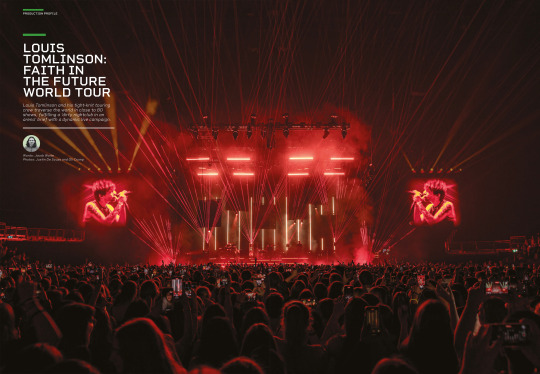
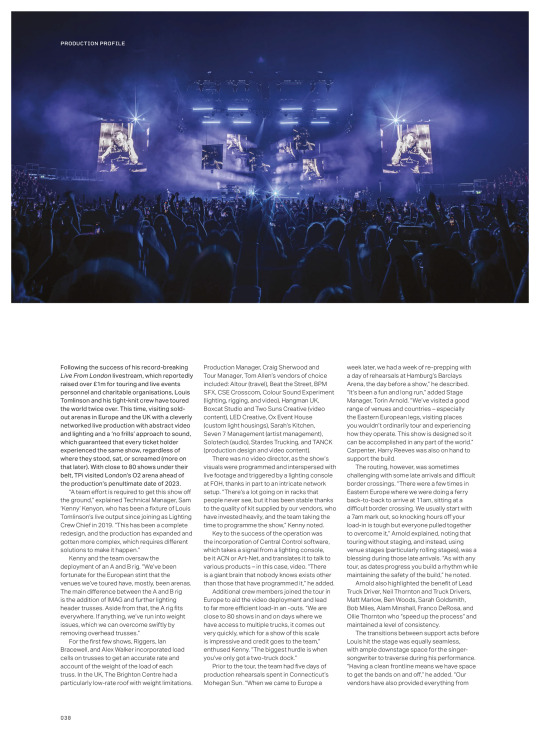
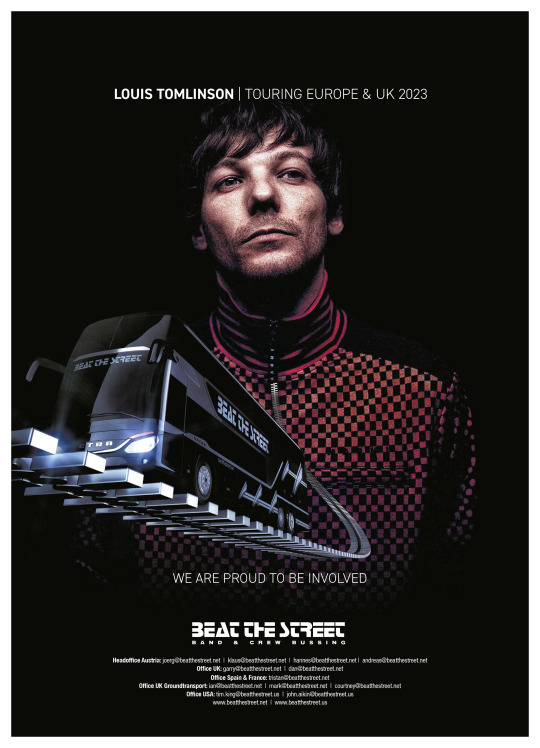
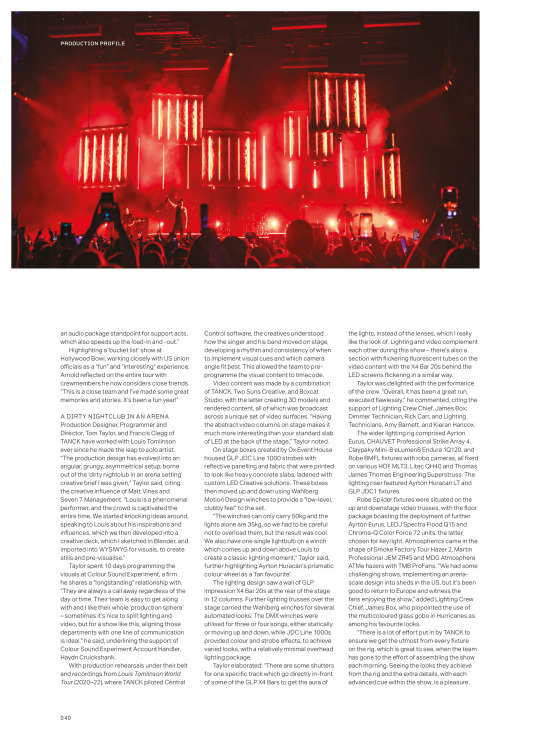

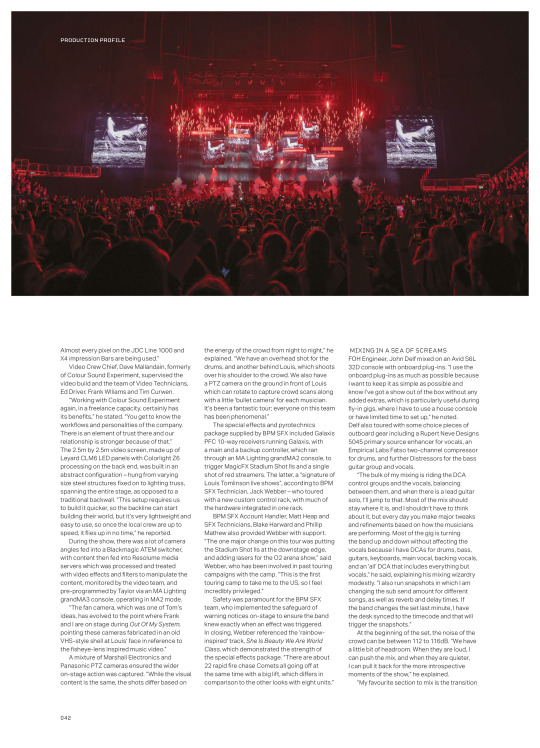
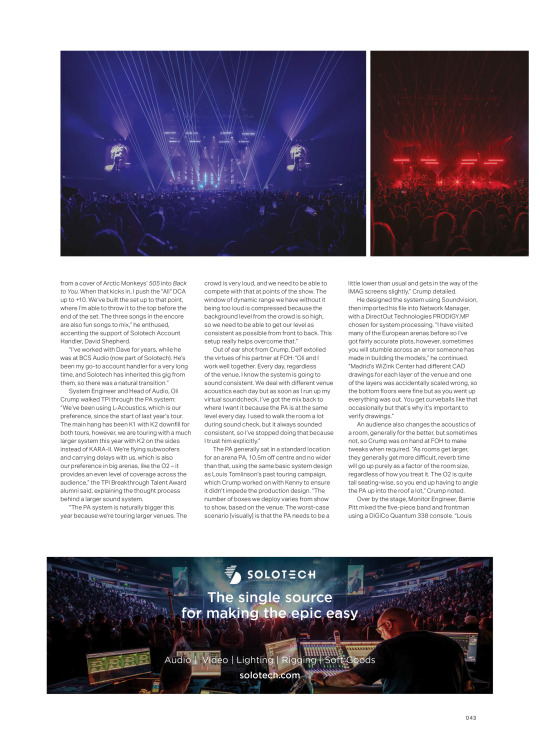
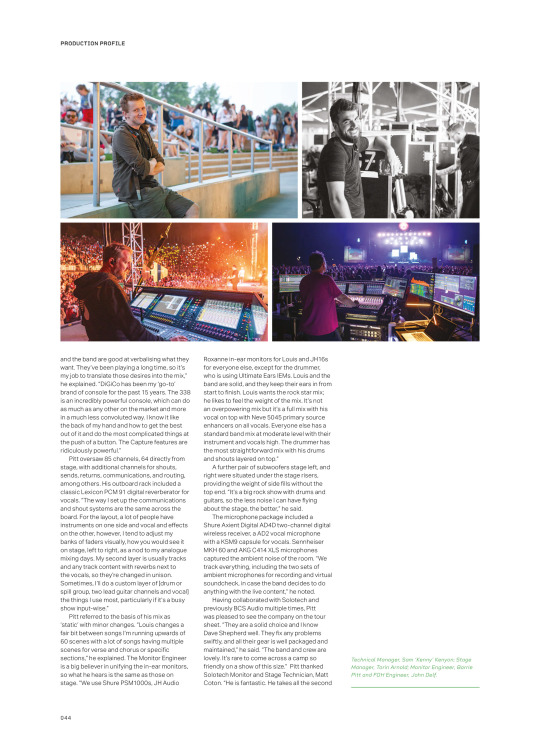

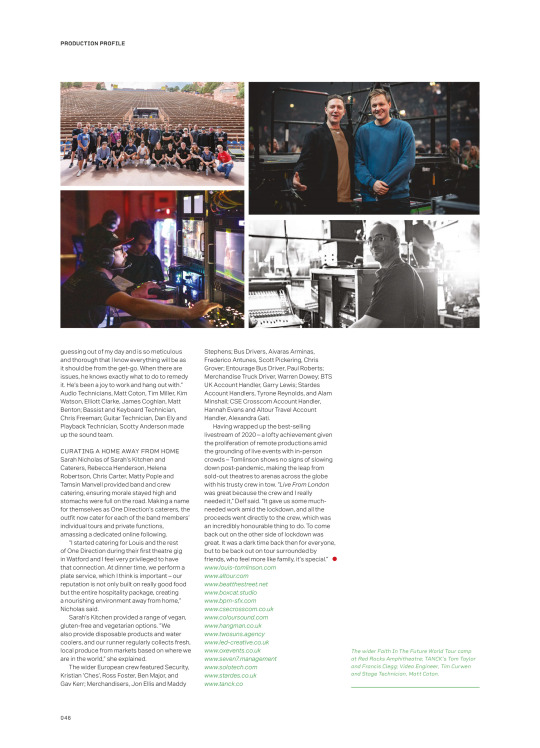
‘A dirty nightclub in an arena’ – behind Louis Tomlinson’s Faith In The Future World Tour
Louis Tomlinson and his tight-knit touring crew traverse the world in close to 80 shows, fulfilling a ‘dirty nightclub in an arena’ brief with a dynamic live campaign.
Production Profiles 5 January 2024
Following the success of his record-breaking Live From London livestream, which reportedly raised over £1m for touring and live events personnel and charitable organisations, Louis Tomlinson and his tight-knit crew have toured the world twice over. This time, visiting sold-out arenas in Europe and the UK with a cleverly networked live production with abstract video and lighting and a ‘no frills’ approach to sound, which guaranteed that every ticket holder experienced the same show, regardless of where they stood, sat, or screamed (more on that later). With close to 80 shows under their belt, TPi visited London’s O2 arena ahead of the production’s penultimate date of 2023.
Words: Jacob Waite Photos: Justin De Souza and Oli Crump
------
Following the success of his record-breaking Live From London livestream, which reportedly raised over £1m for touring and live events personnel and charitable organisations, Louis Tomlinson and his tight-knit crew have toured the world twice over. This time, visiting sold-out arenas in Europe and the UK with a cleverly networked live production with abstract video and lighting and a ‘no frills’ approach to sound, which guaranteed that every ticket holder experienced the same show, regardless of where they stood, sat, or screamed (more on that later). With close to 80 shows under their belt, TPi visited London’s O2 arena ahead of the production’s penultimate date of 2023.
“A team effort is required to get this show off the ground,” explained Technical Manager, Sam ‘Kenny’ Kenyon, who has been a fixture of Louis Tomlinson’s live output since joining as Lighting Crew Chief in 2019. “This has been a complete redesign, and the production has expanded and gotten more complex, which requires different solutions to make it happen.”
Kenny and the team oversaw the deployment of an A and B rig. “We’ve been fortunate for the European stint that the venues we’ve toured have, mostly, been arenas. The main difference between the A and B rig is the addition of IMAG and further lighting header trusses. Aside from that, the A rig fits everywhere. If anything, we’ve run into weight issues, which we can overcome swiftly by removing overhead trusses.”
For the first few shows, Riggers, Ian Bracewell, and Alex Walker incorporated load cells on trusses to get an accurate rate and account of the weight of the load of each truss. In the UK, The Brighton Centre had a particularly low-rate roof with weight limitations. Production Manager, Craig Sherwood and Tour Manager, Tom Allen’s vendors of choice included: Altour (travel), Beat the Street, BPM SFX, CSE Crosscom, Colour Sound Experiment (lighting, rigging, and video), Hangman UK, Boxcat Studio and Two Suns Creative (video content), LED Creative, Ox Event House (custom light housings), Sarah’s Kitchen, Seven 7 Management (artist management), Solotech (audio), Stardes Trucking, and TANCK (production design and video content).
There was no video director, as the show’s visuals were programmed and interspersed with live footage and triggered by a lighting console at FOH, thanks in part to an intricate network setup. “There’s a lot going on in racks that people never see, but it has been stable thanks to the quality of kit supplied by our vendors, who have invested heavily, and the team taking the time to programme the show,” Kenny noted.
Key to the success of the operation was the incorporation of Central Control software, which takes a signal from a lighting console, be it ACN or Art-Net, and translates it to talk to various products – in this case, video. “There is a giant brain that nobody knows exists other than those that have programmed it,” he added.
Additional crew members joined the tour in Europe to aid the video deployment and lead to far more efficient load-in an -outs. “We are close to 80 shows in and on days where we have access to multiple trucks, it comes out very quickly, which for a show of this scale is impressive and credit goes to the team,” enthused Kenny. “The biggest hurdle is when you’ve only got a two-truck dock.”
Prior to the tour, the team had five days of production rehearsals spent in Connecticut’s Mohegan Sun. “When we came to Europe a week later, we had a week of re-prepping with a day of rehearsals at Hamburg’s Barclays Arena, the day before a show,” he described. “It’s been a fun and long run,” added Stage Manager, Torin Arnold. “We’ve visited a good range of venues and countries – especially the Eastern European legs, visiting places you wouldn’t ordinarily tour and experiencing how they operate. This show is designed so it can be accomplished in any part of the world.” Carpenter, Harry Reeves was also on hand to support the build.
The routing, however, was sometimes challenging with some late arrivals and difficult border crossings. “There were a few times in Eastern Europe where we were doing a ferry back-to-back to arrive at 11am, sitting at a difficult border crossing. We usually start with a 7am mark out, so knocking hours off your load-in is tough but everyone pulled together to overcome it,” Arnold explained, noting that touring without staging, and instead, using venue stages (particularly rolling stages), was a blessing during those late arrivals. “As with any tour, as dates progress you build a rhythm while maintaining the safety of the build,” he noted.
Arnold also highlighted the benefit of Lead Truck Driver, Neil Thornton and Truck Drivers, Matt Marlow, Ben Woods, Sarah Goldsmith, Bob Miles, Alam Minshall, Franco DeRosa, and Ollie Thornton who “speed up the process” and maintained a level of consistency.
The transitions between support acts before Louis hit the stage was equally seamless, with ample downstage space for the singer-songwriter to traverse during his performance. “Having a clean frontline means we have space to get the bands on and off,” he added. “Our vendors have also provided everything from an audio package standpoint for support acts, which also speeds up the load-in and -out.”
Highlighting a ‘bucket list’ show at Hollywood Bowl, working closely with US union officials as a “fun” and “interesting” experience, Arnold reflected on the entire tour with crewmembers he now considers close friends. “This is a close team and I’ve made some great memories and stories. It’s been a fun year!”
A DIRTY NIGHTCLUB IN AN ARENA Production Designer, Programmer and Director, Tom Taylor, and Francis Clegg of TANCK have worked with Louis Tomlinson ever since he made the leap to solo artist. “The production design has evolved into an angular, grungy, asymmetrical setup, borne out of the ‘dirty nightclub in an arena setting’ creative brief I was given,” Taylor said, citing the creative influence of Matt Vines and Seven 7 Management. “Louis is a phenomenal performer, and the crowd is captivated the entire time. We started knocking ideas around, speaking to Louis about his inspirations and influences, which we then developed into a creative deck, which I sketched in Blender, and imported into WYSIWYG for visuals, to create stills and pre-visualise.”
Taylor spent 10 days programming the visuals at Colour Sound Experiment, a firm he shares a “longstanding” relationship with. “They are always a call away regardless of the day or time. Their team is easy to get along with and I like their whole ‘production sphere’ – sometimes it’s nice to split lighting and video, but for a show like this, aligning those departments with one line of communication is ideal,” he said, underlining the support of Colour Sound Experiment Account Handler, Haydn Cruickshank.
With production rehearsals under their belt and recordings from Louis Tomlinson World Tour (2020–22), where TANCK piloted Central Control software, the creatives understood how the singer and his band moved on stage, developing a rhythm and consistency of when to implement visual cues and which camera angle fit best. This allowed the team to pre-programme the visual content to timecode.
Video content was made by a combination of TANCK, Two Suns Creative, and Boxcat Studio, with the latter creating 3D models and rendered content, all of which was broadcast across a unique set of video surfaces. “Having the abstract video columns on stage makes it much more interesting than your standard slab of LED at the back of the stage,” Taylor noted.
On stage boxes created by Ox Event House housed GLP JDC Line 1000 strobes with reflective panelling and fabric that were printed to look like heavy concrete slabs, ladened with custom LED Creative solutions. These boxes then moved up and down using Wahlberg Motion Design winches to provide a “low-level, clubby feel” to the set.
“The winches can only carry 50kg and the lights alone are 35kg, so we had to be careful not to overload them, but the result was cool. We also have one single lightbulb on a winch which comes up and down above Louis to create a classic lighting moment,” Taylor said, further highlighting Ayrton Huracán’s prismatic colour wheel as a ‘fan favourite’.
The lighting design saw a wall of GLP impression X4 Bar 20s at the rear of the stage in 12 columns. Further lighting trusses over the stage carried the Wahlberg winches for several automated looks. The DMX winches were utilised for three or four songs, either statically or moving up and down, while JDC Line 1000s provided colour and strobe effects, to achieve varied looks, with a relatively minimal overhead lighting package.
Taylor elaborated: “There are some shutters for one specific track which go directly in-front of some of the GLP X4 Bars to get the aura of the lights, instead of the lenses, which I really like the look of. Lighting and video complement each other during this show – there’s also a section with flickering fluorescent tubes on the video content with the X4 Bar 20s behind the LED screens flickering in a similar way.
Taylor was delighted with the performance of the crew. “Overall, it has been a great run, executed flawlessly,” he commented, citing the support of Lighting Crew Chief, James Box; Dimmer Technician, Rick Carr, and Lighting Technicians, Amy Barnett, and Kieran Hancox.
The wider lighting rig comprised Ayrton Eurus, CHAUVET Professional Strike Array 4, Claypaky Mini-B eLumen8 Endura 1Q120, and Robe BMFL fixtures with robo cameras, all fixed on various HOF MLT3, Litec QH40 and Thomas James Thomas Engineering Superstruss. The lighting riser featured Ayrton Huracan LT and GLP JDC1 fixtures.
Robe Spiider fixtures were situated on the up and downstage video trusses, with the floor package boasting the deployment of further Ayrton Eurus, LEDJ Spectra Flood Q15 and Chroma-Q Color Force 72 units, the latter chosen for key light. Atmospherics came in the shape of Smoke Factory Tour Hazer 2, Martin Professional JEM ZR45 and MDG Atmosphere ATMe hazers with TMB ProFans. “We had some challenging shows, implementing an arena-scale design into sheds in the US, but it’s been good to return to Europe and witness the fans enjoying the show,” added Lighting Crew Chief, James Box, who pinpointed the use of the multicoloured glass gobo in Hurricanes as among his favourite looks.
“There is a lot of effort put in by TANCK to ensure we get the utmost from every fixture on the rig, which is great to see, when the team has gone to the effort of assembling the show each morning. Seeing the looks they achieve from the rig and the extra details, with each advanced cue within the show, is a pleasure.
Almost every pixel on the JDC Line 1000 and X4 impression Bars are being used.”
Video Crew Chief, Dave Mallandain, formerly of Colour Sound Experiment, supervised the video build and the team of Video Technicians, Ed Driver, Frank Wlliams and Tim Curwen.
“Working with Colour Sound Experiment again, in a freelance capacity, certainly has its benefits,” he stated. “You get to know the workflows and personalities of the company. There is an element of trust there and our relationship is stronger because of that.” The 2.5m by 2.5m video screen, made up of Leyard CLM6 LED panels with Colorlight Z6 processing on the back end, was built in an abstract configuration – hung from varying size steel structures fixed on to lighting truss, spanning the entire stage, as opposed to a traditional backwall. “This setup requires us to build it quicker, so the backline can start building their world, but it’s very lightweight and easy to use, so once the local crew are up to speed, it flies up in no time,” he reported.
During the show, there was a lot of camera angles fed into a Blackmagic ATEM switcher, with content then fed into Resolume media servers which was processed and treated with video effects and filters to manipulate the content, monitored by the video team, and pre-programmed by Taylor via an MA Lighting grandMA3 console, operating in MA2 mode.
“The fan camera, which was one of Tom’s ideas, has evolved to the point where Frank and I are on stage during Out Of My System, pointing these cameras fabricated in an old VHS-style shell at Louis’ face in reference to the fisheye-lens inspired music video.”
A mixture of Marshall Electronics and Panasonic PTZ cameras ensured the wider on-stage action was captured. “While the visual content is the same, the shots differ based on the energy of the crowd from night to night,” he explained. “We have an overhead shot for the drums, and another behind Louis, which shoots over his shoulder to the crowd. We also have a PTZ camera on the ground in front of Louis which can rotate to capture crowd scans along with a little ‘bullet camera’ for each musician. It’s been a fantastic tour; everyone on this team has been phenomenal.”
The special effects and pyrotechnics package supplied by BPM SFX included Galaxis PFC 10-way receivers running Galaxis, with a main and a backup controller, which ran through an MA Lighting grandMA2 console, to trigger MagicFX Stadium Shot IIs and a single shot of red streamers. The latter, a “signature of Louis Tomlinson live shows”, according to BPM SFX Technician, Jack Webber – who toured with a new custom control rack, with much of the hardware integrated in one rack.
BPM SFX Account Handler, Matt Heap and SFX Technicians, Blake Harward and Phillip Mathew also provided Webber with support. “The one major change on this tour was putting the Stadium Shot IIs at the downstage edge, and adding lasers for the O2 arena show,” said Webber, who has been involved in past touring campaigns with the camp. “This is the first touring camp to take me to the US, so I feel incredibly privileged.”
Safety was paramount for the BPM SFX team, who implemented the safeguard of warning notices on-stage to ensure the band knew exactly when an effect was triggered. In closing, Webber referenced the ‘rainbow-inspired’ track, She Is Beauty We Are World Class, which demonstrated the strength of the special effects package. “There are about 22 rapid fire chase Comets all going off at the same time with a big lift, which differs in comparison to the other looks with eight units.”
MIXING IN A SEA OF SCREAMS FOH Engineer, John Delf mixed on an Avid S6L 32D console with onboard plug-ins. “I use the onboard plug-ins as much as possible because I want to keep it as simple as possible and know I’ve got a show out of the box without any added extras, which is particularly useful during fly-in gigs, where I have to use a house console or have limited time to set up,” he noted. Delf also toured with some choice pieces of outboard gear including a Rupert Neve Designs 5045 primary source enhancer for vocals, an Empirical Labs Fatso two-channel compressor for drums, and further Distressors for the bass guitar group and vocals.
“The bulk of my mixing is riding the DCA control groups and the vocals, balancing between them, and when there is a lead guitar solo, I’ll jump to that. Most of the mix should stay where it is, and I shouldn’t have to think about it, but every day you make major tweaks and refinements based on how the musicians are performing. Most of the gig is turning the band up and down without affecting the vocals because I have DCAs for drums, bass, guitars, keyboards, main vocal, backing vocals, and an ‘all’ DCA that includes everything but vocals,” he said, explaining his mixing wizardry modestly. “I also run snapshots in which I am changing the sub send amount for different songs, as well as reverb and delay times. If the band changes the set last minute, I have the desk synced to the timecode and that will trigger the snapshots.”
At the beginning of the set, the noise of the crowd can be between 112 to 116dB. “We have a little bit of headroom. When they are loud, I can push the mix, and when they are quieter, I can pull it back for the more introspective moments of the show,” he explained.
“My favourite section to mix is the transition from a cover of Arctic Monkeys’ 505 into Back to You. When that kicks in, I push the “All” DCA up to +10. We’ve built the set up to that point, where I’m able to throw it to the top before the end of the set. The three songs in the encore are also fun songs to mix,” he enthused, accenting the support of Solotech Account Handler, David Shepherd.
“I’ve worked with Dave for years, while he was at BCS Audio (now part of Solotech). He’s been my go-to account handler for a very long time, and Solotech has inherited this gig from them, so there was a natural transition.”
System Engineer and Head of Audio, Oli Crump walked TPi through the PA system: “We’ve been using L-Acoustics, which is our preference, since the start of last year’s tour. The main hang has been K1 with K2 downfill for both tours, however, we are touring with a much larger system this year with K2 on the sides instead of KARA-II. We’re flying subwoofers and carrying delays with us, which is also our preference in big arenas, like the O2 – it provides an even level of coverage across the audience,” the TPi Breakthrough Talent Award alumni said, explaining the thought process behind a larger sound system.
“The PA system is naturally bigger this year because we’re touring larger venues. The crowd is very loud, and we need to be able to compete with that at points of the show. The window of dynamic range we have without it being too loud is compressed because the background level from the crowd is so high, so we need to be able to get our level as consistent as possible from front to back. This setup really helps overcome that.”
Out of ear shot from Crump, Delf extolled the virtues of his partner at FOH: “Oli and I work well together. Every day, regardless of the venue, I know the system is going to sound consistent. We deal with different venue acoustics each day but as soon as I run up my virtual soundcheck, I’ve got the mix back to where I want it because the PA is at the same level every day. I used to walk the room a lot during sound check, but it always sounded consistent, so I’ve stopped doing that because I trust him explicitly.”
The PA generally sat in a standard location for an arena PA, 10.5m off centre and no wider than that, using the same basic system design as Louis Tomlinson’s past touring campaign, which Crump worked on with Kenny to ensure it didn’t impede the production design. “The number of boxes we deploy varies from show to show, based on the venue. The worst-case scenario [visually] is that the PA needs to be a little lower than usual and gets in the way of the IMAG screens slightly,” Crump detailed.
He designed the system using Soundvision, then imported his file into Network Manager, with a DirectOut Technologies PRODIGY.MP chosen for system processing. “I have visited many of the European arenas before so I’ve got fairly accurate plots, however, sometimes you will stumble across an error someone has made in building the models,” he continued. “Madrid’s WiZink Center had different CAD drawings for each layer of the venue and one of the layers was accidentally scaled wrong, so the bottom floors were fine but as you went up everything was out. You get curveballs like that occasionally but that’s why it’s important to verify drawings.”
An audience also changes the acoustics of a room, generally for the better, but sometimes not, so Crump was on hand at FOH to make tweaks when required. “As rooms get larger, they generally get more difficult, reverb time will go up purely as a factor of the room size, regardless of how you treat it. The O2 is quite tall seating-wise, so you end up having to angle the PA up into the roof a lot,” Crump noted.
Over by the stage, Monitor Engineer, Barrie Pitt mixed the five-piece band and frontman using a DiGiCo Quantum 338 console. “Louis and the band are good at verbalising what they want. They’ve been playing a long time, so it’s my job to translate those desires into the mix,” he explained. “DiGiCo has been my ‘go-to’ brand of console for the past 15 years. The 338 is an incredibly powerful console, which can do as much as any other on the market and more in a much less convoluted way. I know it like the back of my hand and how to get the best out of it and do the most complicated things at the push of a button. The Capture features are ridiculously powerful.”
Pitt oversaw 85 channels, 64 directly from stage, with additional channels for shouts, sends, returns, communications, and routing, among others. His outboard rack included a classic Lexicon PCM 91 digital reverberator for vocals. “The way I set up the communications and shout systems are the same across the board. For the layout, a lot of people have instruments on one side and vocal and effects on the other, however, I tend to adjust my banks of faders visually, how you would see it on stage, left to right, as a nod to my analogue mixing days. My second layer is usually tracks and any track content with reverbs next to the vocals, so they’re changed in unison. Sometimes, I’ll do a custom layer of [drum or spill group, two lead guitar channels and vocal] the things I use most, particularly if it’s a busy show input-wise.”
Pitt referred to the basis of his mix as ‘static’ with minor changes. “Louis changes a fair bit between songs I’m running upwards of 60 scenes with a lot of songs having multiple scenes for verse and chorus or specific sections,” he explained. The Monitor Engineer is a big believer in unifying the in-ear monitors, so what he hears is the same as those on stage. “We use Shure PSM1000s, JH Audio Roxanne in-ear monitors for Louis and JH16s for everyone else, except for the drummer, who is using Ultimate Ears IEMs. Louis and the band are solid, and they keep their ears in from start to finish. Louis wants the rock star mix; he likes to feel the weight of the mix. It’s not an overpowering mix but it’s a full mix with his vocal on top with Neve 5045 primary source enhancers on all vocals. Everyone else has a standard band mix at moderate level with their instrument and vocals high. The drummer has the most straightforward mix with his drums and shouts layered on top.”
A further pair of subwoofers stage left, and right were situated under the stage risers, providing the weight of side fills without the top end. “It’s a big rock show with drums and guitars, so the less noise I can have flying about the stage, the better,” he said.
The microphone package included a Shure Axient Digital AD4D two-channel digital wireless receiver, a AD2 vocal microphone with a KSM9 capsule for vocals. Sennheiser MKH 60 and AKG C414 XLS microphones captured the ambient noise of the room. “We track everything, including the two sets of ambient microphones for recording and virtual soundcheck, in case the band decides to do anything with the live content,” he noted.
Having collaborated with Solotech and previously BCS Audio multiple times, Pitt was pleased to see the company on the tour sheet. “They are a solid choice and I know Dave Shepherd well. They fix any problems swiftly, and all their gear is well packaged and maintained,” he said. “The band and crew are lovely. It’s rare to come across a camp so friendly on a show of this size.” Pitt thanked Solotech Monitor and Stage Technician, Matt Coton. “He is fantastic. He takes all the second guessing out of my day and is so meticulous and thorough that I know everything will be as it should be from the get-go. When there are issues, he knows exactly what to do to remedy it. He’s been a joy to work and hang out with.”
Audio Technicians, Matt Coton, Tim Miller, Kim Watson, Elliott Clarke, James Coghlan, Matt Benton; Bassist and Keyboard Technician, Chris Freeman; Guitar Technician, Dan Ely and Playback Technician, Scotty Anderson made up the sound team.
CURATING A HOME AWAY FROM HOME Sarah Nicholas of Sarah’s Kitchen and Caterers, Rebecca Henderson, Helena Robertson, Chris Carter, Matty Pople and Tamsin Manvell provided band and crew catering, ensuring morale stayed high and stomachs were full on the road. Making a name for themselves as One Direction’s caterers, the outfit now cater for each of the band members’ individual tours and private functions, amassing a dedicated online following. “I started catering for Louis and the rest of One Direction during their first theatre gig in Watford and I feel very privileged to have that connection. At dinner time, we perform a plate service, which I think is important – our reputation is not only built on really good food but the entire hospitality package, creating a nourishing environment away from home,” Nicholas said.
Sarah’s Kitchen provided a range of vegan, gluten-free and vegetarian options. “We also provide disposable products and water coolers, and our runner regularly collects fresh, local produce from markets based on where we are in the world,” she explained.
The wider European crew featured Security, Kristian ‘Ches’, Ross Foster, Ben Major, and Gav Kerr; Merchandisers, Jon Ellis and Maddy Stephens; Bus Drivers, Aivaras Arminas, Frederico Antunes, Scott Pickering, Chris Grover; Entourage Bus Driver, Paul Roberts; Merchandise Truck Driver, Warren Dowey; BTS UK Account Handler, Garry Lewis; Stardes Account Handlers, Tyrone Reynolds, and Alam Minshall; CSE Crosscom Account Handler, Hannah Evans and Altour Travel Account Handler, Alexandra Gati.
Having wrapped up the best-selling livestream of 2020 – a lofty achievement given the proliferation of remote productions amid the grounding of live events with in-person crowds – Tomlinson shows no signs of slowing down post-pandemic, making the leap from sold-out theatres to arenas across the globe with his trusty crew in tow. “Live From London was great because the crew and I really needed it,” Delf said. “It gave us some much-needed work amid the lockdown, and all the proceeds went directly to the crew, which was an incredibly honourable thing to do. To come back out on the other side of lockdown was great. It was a dark time back then for everyone, but to be back out on tour surrounded by friends, who feel more like family, it’s special.”
-> read here on Issuu
#louis#fitf tour#fitfwt#lt crew#tpi magazine#05.01.24#article#touring#thank youu omglarryrabbit ;)#love getting to peek behind the scenes this is great
101 notes
·
View notes
Text
Engineers who work for Elon Musk’s SpaceX have been brought on as senior advisers to the acting administrator of the Federal Aviation Administration (FAA), sources tell WIRED.
On Sunday, Sean Duffy, secretary of the Department of Transportation, which oversees the FAA, announced in a post on X that SpaceX engineers would be visiting the Air Traffic Control System Command Center in Virginia to take what he positioned as a tour. “The safety of air travel is a nonpartisan matter,” Musk replied. “SpaceX engineers will help make air travel safer.”
By the time these posts were made, though, according to sources who were granted anonymity because they fear retaliation, SpaceX engineers were already being onboarded at the agency under Schedule A, a special authority that allows government managers to “hire persons with disabilities without requiring them to compete for the job,” according to the Office of Personnel Management (OPM).
These new hires come after the terminations of hundreds of FAA probationary employees, and the most deadly month of US aviation disasters in more than a decade.
According to a source with knowledge of the situation, none of the SpaceX engineers were fully vetted by their start date. Unlike the very young technologists associated with Musk’s so-called Department of Government Efficiency (DOGE) who have been given access to critical systems at agencies ranging from OPM and the Treasury Department to the National Oceanic and Atmospheric Administration in recent weeks, though, the engineers identified by WIRED—Ted Malaska, Thomas Kiernan, Sam Smeal, and Brady Glantz—do appear to have experience relevant to the FAA.
Malaska is currently, according to his LinkedIn profile, a senior director of application software at SpaceX, where he started working in May 2021. Formerly the senior director of data engineering at Capitol One and a senior architect at FINRA, he graduated from the University of Maryland Baltimore County in 2000 and cowrote a 2015 book on Hadoop application architectures.
Kiernan is currently a lead software engineer at SpaceX, according to his LinkedIn page. Before joining SpaceX in May 2020, he worked at Wayfair and is a 2017 Dartmouth graduate.
Smeal is a software engineer who has worked at SpaceX since September 2021, according to his LinkedIn. He graduated from Saint Vincent College in 2018.
Glantz is a software engineer who has worked at SpaceX since May 2024 and worked as an engineering analyst at Goldman Sachs from 2019 to 2021, according to his LinkedIn, and graduated from the University of Michigan in 2019.
Malaska, Kiernan, Smeal, and Glantz did not immediately respond to requests for comment. The FAA also did not immediately respond to requests for comment.
In his post on X, Duffy wrote, "Because I know the media (and Hillary Clinton) will claim Elon’s team is getting special access, let me make clear that the @FAANews regularly gives tours of the command center to both media and companies.”
But on Wednesday, FAA acting administrator Chris Rocheleau wrote in an email to FAA staff, viewed by WIRED, that DOGE and the teams of special government employees deployed in federal agencies were “top-of-mind,” before noting that the agency had "recently welcomed” a team of special government employees who had already toured some FAA facilities. “We are asking for their help to engineer solutions while we keep the airspace open and safe,” he wrote, adding that the new employees had already visited the FAA Command Center and Potomac TRACON, a facility that controls the airspace around and provides air traffic control services to airports in the DC, Maryland, and Virginia areas.
In a Department of Transportation all-hands meeting late last week, Duffy responded to a question about DOGE's role in national airspace matters, and without explicitly mentioning the new employees, suggested help was needed on reforming Notice to Air Mission (NOTAM) alerts, a critical system that distributes real-time data and warnings to pilots but which has had significant outages, one as recently as this month. “If I can get ideas from really smart engineers on how we can fix it, I’m going to take those ideas,” he said, according to a recording of the meeting reviewed by WIRED. “Great engineers” might also work on airspace issues, he said.
SpaceX functioned as the pre-inauguration staging ground for the DOGE team, according to reporting from The New York Times and sources who spoke to WIRED. In the months between November 5 and January 20, members of DOGE including Steve Davis (president of Musk’s Boring Company) and the young engineer Luke Farritor were operating out of the company’s DC office, according to a source with knowledge.
The company did not respond to questions about whether these employees will retain their salaries and positions at the company during their time with DOGE. Many of the so-called department’s operatives have joined as “special government employees,” who are limited to working 130 days in a year. Last week WIRED reported that Tom Krause, a DOGE operative at the Treasury Department, would continue to maintain his position as CEO of the Cloud Software Group while also performing the duties of fiscal assistant secretary. Other members of Musk’s companies, including xAI and Tesla, have also taken on positions with DOGE.
Late last week, the Trump administration laid off 400 FAA workers, according to their union, the Professional Aviation Safety Specialists. The union says these included probationary employees who worked on air traffic control communications and related radio and computer systems. Air traffic controllers were not affected by the layoffs, Duffy said in an X post.
Just two weeks before that, the US suffered its most deadly aviation incident in more than a decade, when 67 people died after an Army helicopter collided with a passenger jet in Washington, DC. Though initial findings suggest complex equipment and communications issues possibly played roles in the disaster, President Trump was quick to blame “DEI,” railing against a decade-old program that helps the FAA identify talent among populations with disabilities. People with disabilities hired into the FAA and other federal agencies are often accepted under the Schedule A authority—exactly the route these new engineers have taken into the agency.
The FAA has frequently tangled with Musk’s SpaceX, as the rocket company and others fight to operate their own interests in crowded American airspace. In January, the FAA temporarily grounded SpaceX’s program after one of its Starship rockets broke apart midflight, reportedly damaging public property on Turks and Caicos in the Caribbean. The FAA diverted dozens of commercial airline flights following the explosion and announced an investigation into the incident, which is ongoing and being led by SpaceX. Musk, however, characterized the failure as “barely a bump in the road” and did not seem to indicate that the investigation would slow SpaceX’s launch cadence. Last year, the company indicated it was aiming for 25 launches of the Starship in 2025.
FAA spokesperson Steven Kulm told WIRED that “the FAA is overseeing the SpaceX-led mishap investigation.” The FAA did not respond to further questions about whether the presence of SpaceX engineers at the agency would constitute a conflict of interest.
In September, the FAA proposed $633,000 in fines following two 2023 incidents in which SpaceX allegedly did not follow its license requirements, violating regulations. Responding to an X user posting about the penalties, Musk wrote, “The fundamental problem is that humanity will forever be confined to Earth unless there is radical reform at the FAA!” Shortly afterward, Musk called for FAA head Mike Whitaker to resign.
In January, more than three years before his term was due to end, Whitaker did resign.
“I told Elon, any conflicts, you can’t have anything to do with that,” said President Trump in a press conference this week, in response to a question about Musk, SpaceX, the FAA, and conflicts of interest. ���So anything to do with possibly even space, we won’t let Elon partake in that.”
The White House did not immediately respond to a request for comment.
SpaceX is directly regulated by a small FAA agency called the Office of Commercial Space Transportation, which since 1984 has licensed the launch of US space rockets. “The purpose is to ensure public safety,” says George Nield, a former associate administrator of the office. “People on the ground did not consent” to rocket launches above them, he says. ”We absolutely need to keep them safe. The office has done a great job of that.” The office oversaw 157 launches in 2024 alone.
On February 10, several days after Musk posted on X that DOGE “will aim to make rapid safety upgrades to the air traffic control system,” a group of Democratic legislators wrote to Rocheleau—a career civil servant whose ties to the FAA go back to 1996—requesting information about any planned changes to FAA systems.
“We are extremely concerned that an ad hoc team of individuals lacking any expertise, exposure, certifications, or knowledge of aviation operations being invited, or inserting themselves, to make ‘rapid’ changes to our nation’s air traffic systems,” they wrote. “Aviation safety is not an area to ‘move fast and break things.’”
7 notes
·
View notes
Text

Hi there, are you a new friend? Gasp!!! I love helping new friends! Since you’re new here, you must know nothing about the Friendship Labs, oh no! I can help with that, I love to help!
My name is Clover! They/them. I’m a friendprogram! I’ll be your tour guide throughout this week, I hope I can help you and you have lots of fun!
Well, well, I suppose we should start from the first friendship area… Although, technically, the very first place would be the Reprogram Town, but it’s been sealed for years. I don’t really get why! I hope one day they decide to open up the town, I’d love to meet everyone there!
But yes, since we can’t access that part of the lab yet, the next first area would be…
The Emulation Area!
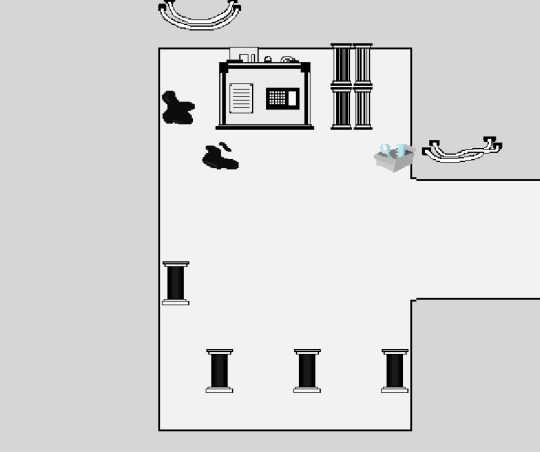
Oh this area is so wonderful! It’s all connected to the… emulation software! A software that is able to create a simulation of anything ever imaginable, isn't’ that amazing?! With its help, we are able to create tests that are more immersive, that way the programs that go through the tests will feel more motivated to perform better as friends!
The emulation software is found in all of the lab, but it’s mainly focused on the Emulation Area above all else. Whoever is in charge of managing this software must be very busy, but I thank them for all their efforts? Have I ever met them? I’d love to, but I haven’t! Maybe I should visit them myself, thank you for your clever ideas, friend!

How do the tests work? That’s easy! There are different rooms that offer you a particular scenario, you just need to find a friendly solution. The tests are changed every so often, so that we don’t always go through the same scenario over and over and we are able to be prepared for anything! I’ve heard that right now, the emulation area has a library test and a beach test. There are more than that, but those are the only two I remember! I don’t have to go through a test right now, so I haven’t been there in a while. I think next month I might need to go, so I’m excited!

You’ve heard of a pixelated program? Oh yeah! She’s the complete opposite of what a good friend should be, it’s so strange! I have offered her some friendly advice but it always ignores me, which is very rude… But I hope someone is able to help them! I find it very strange that nobody has tried to do anything so far, mhmm...
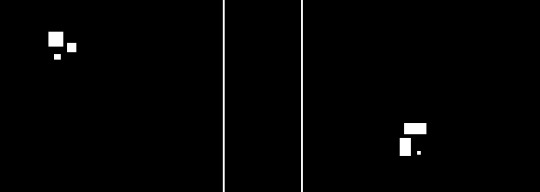
But oh well! Did you like the Emulation Area? Maybe you can go visit it soon! Next up, the Heartbreak Area!
10 notes
·
View notes
Text

Still kickin' since the '70s: NASA's Voyager mission keeps exploring
NASA's Voyager mission launched in the 1970s. Today, it's making history as it conducts new science. But how are two spacecraft from the '70s not just surviving, but thriving farther out in space than any other spacecraft has been before?
A little mission background
Voyager is a NASA mission made up of two different spacecraft, Voyager 1 and 2, which launched to space on Sept. 5, 1977, and Aug. 20, 1977, respectively. In the decades following launch, the pair took a grand tour of our solar system, studying Jupiter, Saturn, Uranus, and Neptune—one of NASA's earliest efforts to explore the secrets of the universe.
These twin probes later became the first spacecraft to operate in interstellar space—space outside the heliosphere, the bubble of solar wind and magnetic fields emanating from the sun. Voyager 1 was the first to enter interstellar space in 2012, followed by Voyager 2 in 2018.
Today, Voyager continues not just because it can, but because it still has work to do studying interstellar space, the heliosphere, and how the two interact. "We wouldn't be doing Voyager if it wasn't taking science data," said Suzanne Dodd, the mission's current project manager and the director for the Interplanetary Network at NASA's Jet Propulsion Laboratory.
But across billions of miles and decades of groundbreaking scientific exploration, this trailblazing interstellar journey has not been without its trials. So, what's the Voyager secret to success?
In short: preparation and creativity.
"We designed them not to fail"
According to John Casani, Voyager project manager from 1975 to launch in 1977, "we didn't design them to last 30 years or 40 years, we designed them not to fail."
One key driver of the mission's longevity is redundancy. Voyager's components weren't just engineered with care, they were also made in duplicate.
According to Dodd, Voyager "was designed with nearly everything redundant. Having two spacecraft—right there is a redundancy."
A cutting-edge power source
The twin Voyager spacecraft can also credit their longevity to their long-lasting power source.
Each spacecraft is equipped with three radioisotope thermoelectric generators. These nuclear "batteries" were developed originally by the U.S. Department of Energy as part of the Atoms for Peace program enacted by President Eisenhower in 1955.
Compared to other power options at the time—like solar power, which doesn't have the reach to work beyond Jupiter—these generators have allowed Voyager to go much farther into space.
Voyager's generators continue to take the mission farther than any before, but they also continue to generate less power each year, with instruments needing to be shut off over time to conserve power.
Creative solutions
As a mission that has operated at the farthest edges of the heliosphere and beyond, Voyager has endured its fair share of challenges. With the spacecraft now in interstellar space running on software and hardware from the 1970s, Voyager's problems require creative solutions.
Retired mission personnel who worked on Voyager in its earliest days have even come back out of retirement to collaborate with new mission personnel to not just fix big problems but to pass on important mission know-how to the next generation of scientists and engineers.
"From where I sit as a project manager, it's really very exciting to see young engineers be excited to work on Voyager. To take on the challenges of an old mission and to work side by side with some of the masters, the people that built the spacecraft," Dodd said. "They want to learn from each other."
Within just the last couple of years, Voyager has tested the mission team's creativity with a number of complex issues. Most recently, a fuel tube inside of Voyager 1's thrusters, which control the spacecraft's orientation and direction, became clogged. The thrusters allow the spacecraft to point their antennae and are critical to maintaining communications with Earth. Through careful coordination, the mission team was able to remotely switch the spacecraft to a different set of thrusters.
These kinds of repairs are extra challenging as a radio signal takes about 22½ hours to reach Voyager 1 from Earth and another 22½ hours to return. Signals to and from Voyager 2 take about 19 hours each way.
Voyager's interstellar future
This brief peek behind the curtain highlights some of Voyager's history and its secrets to success.
The Voyager probes may continue to operate into the late 2020s. As time goes on, continued operations will become more challenging as the mission's power diminishes by 4 watts every year, and the two spacecraft will cool down as this power decreases. Additionally, unexpected anomalies could impact the mission's functionality and longevity as they grow older.
As the mission presses on, the Voyager team grows this legacy of creative problem solving and collaboration while these twin interstellar travelers continue to expand our understanding of the vast and mysterious cosmos we inhabit.
6 notes
·
View notes
Text
Tour Booking System | Tour Package Booking System
eWeblink presents an innovative and user-friendly Tour Package Booking System, offering a seamless online booking experience for travelers worldwide. Our cutting-edge tour booking software simplifies the entire booking process, ensuring efficiency, convenience, and reliability for both customers and tour operators.
Contact us- 9015 8585 65
#eweblink#tour booking software#tour booking system#tour package booking system#eweblink technology#travel portal development company#travel portal development#travel software development#travel portal devel#travel portal solutions#travel tech solutions
0 notes